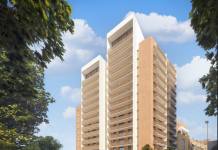With environmental concerns increasingly at the fore, the three ‘Rs’ have been redefined to mean ‘reduce, reuse, recycle’ – preferably in that order. So why isn’t the trend for facadism – where developers maintain just the front façade of historic buildings, demolish the interior and create a modern space within – declining in popularity in favour of the greener alternative of refurbishment?
Niall Murphy, a partner with national law firm Clarke Willmott LLP and head of their business tax team, makes the case for lifting the restrictions that currently apply, such as the requirement for being empty for two years, which would simplify the regime.
He makes the case for abolishing VAT on the refurbishment of properties that have been empty for more than two years to replace the current (reduced) rate of VAT of 5%, and lifting the restrictions that currently apply.
Niall Murphy said: “At the moment VAT relief at the zero rate is only available for the construction of buildings that are either designed as dwellings or are intended solely for a relevant residential or charitable purpose.
“The general rule is that an existing building must be demolished completely to ground level in order for the construction of its replacement to be treated as the construction of a building. Otherwise the works would be seen as the construction of part of a building.
“The effect of this is to deny VAT relief to buildings that are not constructed ‘from scratch’. This means that where a building already exists on the site of a development project, that building must have first been demolished completely to ground level in order for a building, which is to be constructed to replace it, to qualify for zero-rating.
“The law allows this condition to be relaxed where there is a legal requirement (for example under a statutory planning consent) to retain a facade of the previously existing building (or two facades on a corner site). In this case the law allows the work to be zero-rated as the construction of a building.
“There is no definition within VAT legislation of the term ‘facade’ but HMRC’s view remains that it is the complete front of a building that usually faces a street, road or some other thoroughfare (including a river or canal) and is the exterior part of a building that is most likely to be seen by passers-by or approaching visitors.
“A corner site will also look out onto, for example, a street or road, but from two sides and as a result, will have two facades. The two facades that are required to be retained must connect to form a corner.
“Party walls may be ignored if they are walls that are shared with adjoining buildings such as in semi-detached or terraced houses.
“HMRC accepts that in order to establish whether a building is being constructed one needs to take into account the nature of the work. The retention of a minimal amount of an already existing building will be sufficient to disqualify the work from zero-rated relief.”
“It would be unfair to put all the blame on VAT. Other influencers include rising land prices, the dismantling of planning controls, cuts to council planning staff – more than a third of experienced conservation officers have been lost since 2006 – and the demands of fire and other building regulations.
“But a change in VAT to incentivise repair and reuse would be an easy win in the battle to sustain the environment.”



















